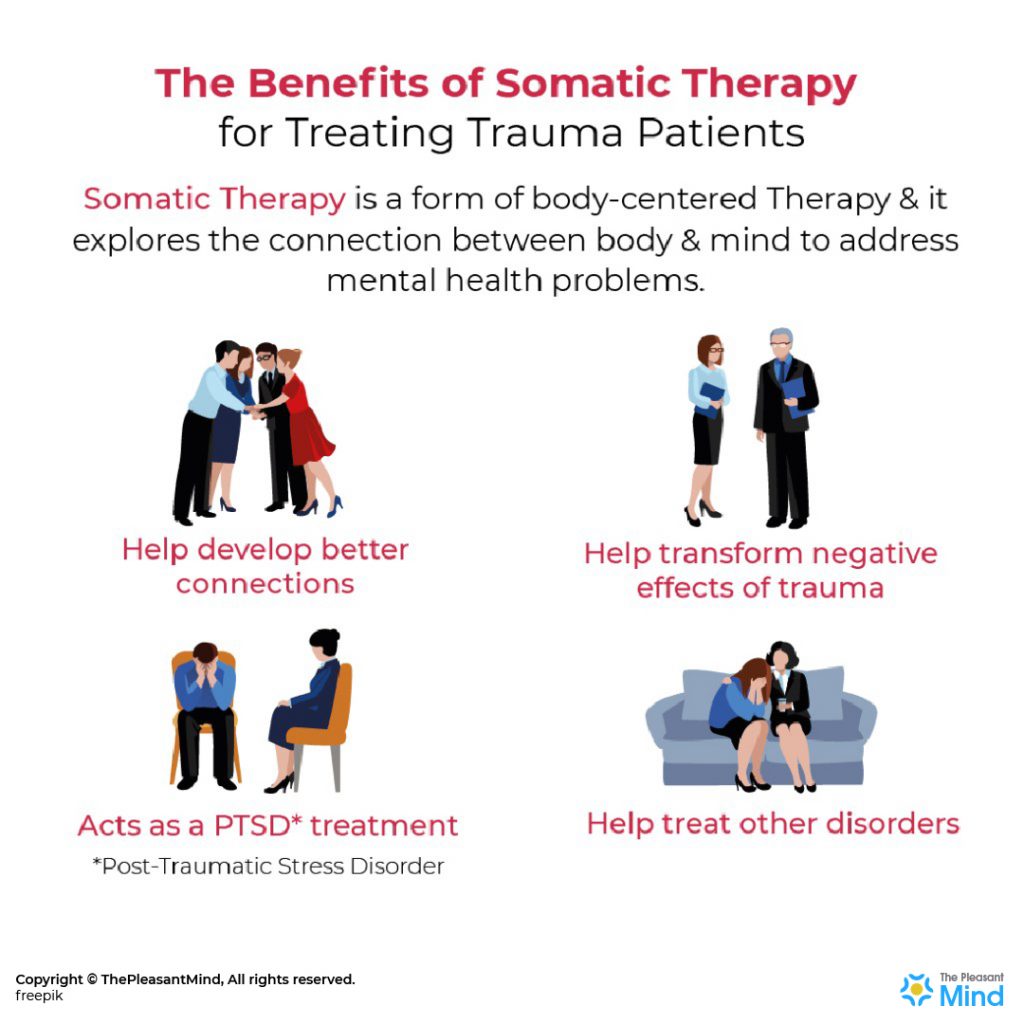
Life is a series of unfortunate events. Besides those who were born with a silver spoon in their mouth, all of us faced unsavory situations. It can be as small as getting stuck in traffic, or as big as facing the death of a family member.
Life is essentially a loop of positive and negative experiences. While most of the events leave us relatively unaffected, some of them do cause a change in our brain’s physiology.
Chronic illness, near-death experiences, abusive childhoods – these are just a few examples of life experiences that can result in trauma.
Psychological sciences and neurosciences have been working relentlessly to find newer and better ways to help people who suffer from such traumatic experiences.
Somatic Therapy is one of them. The process can reverse the damage caused to the body and mind by distressing events and traumatic memories.
Somatic Therapy Infographic

What is Somatic Therapy?
SUMMARY
Somatic Therapy uses the connection between body and mind to address mental health issues. It is a holistic method of treating physical and emotional pain.
In layman’s terms, somatic Therapy is a form of body-centered Therapy. It explores the connection between the body and the mind to address mental health problems arising from traumatic experiences.
Western medicine has long treated the body and mind as two separate entities. However, several holistic therapy methods have emerged in the last two decades.
These methods aim to explore how physical sensations can affect the psychology of a person. Somatic Therapy is an extension of the same.
Also known as somatic psychotherapy, this method looks at the connection of the body and mind. It uses both psychotherapy and physical Therapy for relieving physical and emotional pain.
Physical symptoms may reflect the unpleasant sensations associated with a traumatic event. This is the core of somatic psychotherapy. These symptoms affect posture, facial expressions, muscular discomfort, and other body sensations.
This is why this method is known as body psychotherapy or body-oriented psychotherapy.
WARNING
Somatic Therapy often has a positive effect on trauma patients, but it must not be seen as a replacement for traditional therapy. It cannot completely resolve deep-rooted mental health problems.
How did Somatic Therapy Come to be Recognized as a Therapeutic Tool?
SUMMARY
Wilhelm Reich was the first psychoanalyst to understand the potential of Somatic Therapy as a therapeutic tool. Peter Levine observed wild animals formulate the concept of somatic experiencing – the basis of Somatic Therapy.
Wilhelm Reich, an Austrian psychoanalyst, is one of the most influential personalities in the history of somatic Therapy. He was one of the first psychologists to recognize its potential as a therapeutic process.
In his book Character Analysis, he writes that repressed emotions are reflected in a person’s muscular tension, physical movements, and posture. He concluded that physical pressure is necessary to permit complete emotional release.
Psychotherapist Peter Levine had similar ideas. He realized that traumatic life-and-death experiences do not have any effect on animals in the wild. On the other hand, humans can be severely traumatized by such events.
He noticed that animals react fully to dangerous events by completing the full cycle of fight and flight. This involves noticing the treat, reacting to it, and then recovering.
Levine observed that in wild animals, there is a discharge of excess energy from the body once the threat is eliminated. This may be in the form of trembling, bucking, shaking, or running.
It helps the animals return to baseline activity. On the other hand, humans tend to interrupt this sequence.
In his book Waking the Tiger, Dr. Levine talks about restoring the nervous system to its baseline. This can be done by allowing the physiological responses to trauma to manifest throughout the body, instead of only through thoughts and emotions.
He called this Somatic Experiencing. Somatic Psychotherapy is an application of the same.
How Does Somatic Therapy Work?
SUMMARY
Somatic Therapy helps return the Autonomic Nervous System to homeostasis, and thus release bodily tensions retained after traumatic experiences.
The core theory at the center of somatic psychology is that distressing events and traumatic experiences influence the central nervous system. It leads to the disruption or instability of the autonomic nervous system (ANS).
The normal response of the human body to trauma is extremely helpful in dangerous situations. But the nervous system can remain stuck in this fight or flight state for a long period. This may be in the form of chronic tension, arousal, or complete shutdown.
This state can manifest in the form of altered body language, facial expressions, and posture. In a few cases, this may also result in physical pain, depression, sexual problems, hormonal issues, digestive problems, anxiety, and addiction.
Somatic Therapy can restore the ANS to its normal functioning. This is done by helping people become more aware of their somatic experiences and body sensations. The techniques used in Somatic Therapy release the tension the body is holding.
The techniques used may include grounding exercises, mindful breathing, dance or other movements, sensation awareness, massages, voice work, etc. These exercises help patients develop an understanding of the connection between the body and the mind.
The goal of Somatic Therapy is to release negative emotions like tension, frustration, and anger. It helps the patients destress, and get rid of the physical pain that prevents that from living a full life.
TIP
Somatic therapy practitioners can use the therapy sessions to encourage patients to reflect on their behavior and thought patterns. When used with traditional talk therapy, it can help people identify the effect of their traumatic past on current experiences and emotions.
Types of Somatic Therapy
SUMMARY
Neurosomatic Therapy focuses on physical pain, whereas Somatic Experiencing Therapy is focused on releasing nervous energy. The latter is of two types – Pendulation and Titration.
Somatic Therapy can take many forms. Besides the ones mentioned above, here are two other forms:
Neurosomatic Therapy:
Neurosomatic Therapy addresses problems related to the nervous system, skeletal system, and soft tissues. It relieves sources of physical pain and can help people suffering from chronic physical pain. It includes massage, posture correction, and exercises that help with balance issues.
Somatic Experiencing Therapy:
This technique involves focusing on the physical sensations and symptoms that may be the result of a distressing or traumatic event. The therapist is more focused on the body memory of the event rather than the thought content.
It helps patients discharge nervous energy build-up in a safe and secure manner. It is of further two types:
Titration – In this technique, the therapist asks you to relive the trauma memory and notice the physical changes as you describe the event. Gradually, he or she will teach you to deal with these symptoms completely as they occur.
Pendulation – In this method, the therapist guides you from a relaxed state to the trauma state where you experience unstable excitement, frustration, fear, or arousal.
He or she will then guide you to return to the relaxed state again. This is done several times to discharge the nervous energy.
Other forms of Somatic Therapy include – Kinetic Awareness, Ayurveda, Reiki, Acupressure, Mediation in Movement, Martial Arts, Polarity Therapy, etc.
Benefits of Somatic Therapy
SUMMARY
Somatic Therapy helps patients reduce stress, gain confidence, and explore emotional pain in a better way. It also plays a key role in PTSD treatment and has shown promise in treating borderline personality disorders, anorexia, and schizophrenia.
Mind-body Therapy uses the connection between mental and physical responses to help patients deal with trauma.
1. Develop better connections
It can help patients develop a greater sense of self-awareness, relieve physical distress, and develop a better connection with others. People receiving the therapy can make better sense of their bodies, and explore emotional problems in a better way.
2. Transform negative effects of trauma
The therapy sessions can also transform the negative events. It helps the patient develop a greater sense of self-esteem, confidence, hope, and resilience. It can also reduce stress and physical pain while increasing the ability to concentrate.
3. PTSD treatment
Body-oriented psychotherapies have shown improvement in PTSD patients’ ability to handle posttraumatic stress. Trauma expert Bessel van der Kolk has revealed that somatic experiences may be essential for PTSD treatment.
4. Treatment of other disorders
Other benefits of Somatic Therapy include – improved emotional regulation, decreased symptoms of mood disorders such as anxiety and depression, improved interpersonal relationships.
Research has also suggested that somatic Therapy may be helpful in the treatment of borderline personality disorders as well, anorexia nervosa, and schizophrenia.
Things to Remember While Choosing a Somatic Therapist
SUMMARY
Find a therapist who is educated in somatic therapy techniques, is experienced, and has a positive approach. You should also feel comfortable and safe with him/her.
Somatic Therapy works best when it is integrated with traditional talk therapy, counseling sessions, and psychotherapy. It is essential to look for an experienced mental health professional. He or she should have supervised training in advanced therapy techniques.
In addition to finding a therapist who has the right educational background, experience, and a positive outlook, it is also important to find a therapist you feel comfortable with.
Some Somatic Therapy techniques involve touch, so it is imperative that you feel safe and secure with your therapist.
Limitations of Somatic Therapy
SUMMARY
The use of touch during Somatic Therapy raises some ethical problems. It can be disturbing for patients of sexual abuse, and can also lead to transference and countertransference. Due to a lack of scientific evidence, some countries do not recognize Somatic Therapy methods at all.
Despite its immense benefits, there are some concerns regarding the use of somatic methods for Therapy. The major ethical concern is touch.
Some patients may find physical contact during therapy reassuring. It can result in the reduction of pain, as well as help release tension. But patients affected by sexual abuse may find it jarring to be physically touched. However, this is not true for all patients.
Psychologists have also debated the unintended consequences of touch. It can lead to patients feeling frightened, aroused, or sexual during the sessions. These emotions can further lead to more complicated problems like transference and countertransference.
Body psychotherapy has not met the rigorous standards of the scientific community in many countries. Tests regarding the scientific validity of this method are still in progress. That is why such therapies are not yet accepted in many countries.
CAUTION
For somatic Therapy to work, both the patient and the therapist must consent to touch. Patients also need to have the ability to develop body awareness.
Final Thoughts
Somatic Therapy is not the be-all, end-all of trauma treatment, but it can certainly aid recovery in such patients. Patients with PTSD and other mental disorders should remember that dealing with the physical effects of trauma is just as important as rectifying the mental effects.
Body-centered psychotherapy can help patients regain the health and power of their bodies. These techniques are also effective for understanding mental and emotional changes. Remember – you only have one body.
It is important to take care of it if you want to live a happier, calmer, and more satisfying life.
Article Sources
1. https://www.psychologytoday.com/us/therapy-types/somatic-therapy
2. https://psychcentral.com/blog/how-somatic-therapy-can-help-patients-suffering-from-psychological-trauma
3. https://www.talkspace.com/blog/somatic-therapy-what-is-definition-get-started-guide/
Are you interested to know more about ‘Art Therapy’ then click here?
Surabhi has a deep passion for words. She puts her heart and mind into whatever she pursues and craves for creative ventures. She has always been keen on creating original content that can make a difference. In her experience as a content writer, she has had the opportunity to work on several fields with Psychology being her favorite. Surabhi says, words have the power to transform the world, better than a sword. So she hopes to contribute her bit to this revolution. At ThePleasantConversation, she feels lucky to have the opportunity to share content capable of bringing about a change in the lives of the readers.